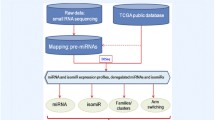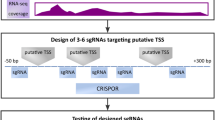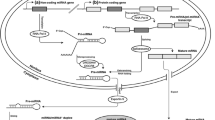Abstract
miRNA variants (termed isomiRs) have been reported as potential functional molecules that may affect miRNA stability or target selection. The aims of the present study were to comprehensively survey and characterize non-template nucleotides (NTNs) and isomiR repertoires in miRNAs. Over 50 % of the NTNs were located in the 3′ ends (also termed 3′ additions), followed by the 5′ ends and adjacent positions to 5′ and 3′ ends. The similar distributions of NTNs and isomiR repertoires might be detected between homologous or clustered miRNAs. miRNA might be stably expressed based on the typical analysis, but its isomiRs might be strongly up- or down-regulated. IsomiRs with novel seed sequences were mainly derived from “seed shifting” events in 5′ isomiRs, NTNs in 5′ ends or in seed sequences. IsomiRs from a miRNA locus or homologous miRNA loci maybe have the same seed sequences, but they would have various enrichment levels and 3′ ends. Interestingly, isomiR species with novel seed sequences via NTNs in the seed region were always stably expressed. These novel seed sequences could lead to novel functional roles through driving the potential novel target mRNAs. Integrated predicted target mRNAs and further microarray validation showed that these isomiRs have versatile biological roles. Collectively, multiple isomiR products and miRNA maturation processes provide opportunities to perform versatile roles in the regulatory network, which further enriches and complicates the regulation of biological processes.




Similar content being viewed by others
References
Carthew RW, Sontheimer EJ (2009) Origins and Mechanisms of miRNAs and siRNAs. Cell 136:642–655
Guo H, Ingolia NT, Weissman JS, Bartel DP (2010) Mammalian microRNAs predominantly act to decrease target mRNA levels. Nature 466:835–840
Huntzinger E, Izaurralde E (2011) Gene silencing by microRNAs: contributions of translational repression and mRNA decay. Nat Rev Genet 12:99–110
Bartel DP (2004) MicroRNAs: genomics, biogenesis, mechanism, and function. Cell 116:281–297
Lai EC (2002) Micro RNAs are complementary to 3′ UTR sequence motifs that mediate negative post-transcriptional regulation. Nat Genet 30:363–364
Lewis BP, Shih IH, Jones-Rhoades MW, Bartel DP, Burge CB (2003) Prediction of mammalian microRNA targets. Cell 115:787–798
Betel D, Wilson M, Gabow A, Marks DS, Sander C (2008) The microRNA.org resource: targets and expression. Nucleic Acids Res 36:D149–D153
Friedman RC, Farh KK, Burge CB, Bartel DP (2009) Most mammalian mRNAs are conserved targets of microRNAs. Genome Res 19:92–105
Krek A, Grun D, Poy MN, Wolf R, Rosenberg L et al (2005) Combinatorial microRNA target predictions. Nat Genet 37:495–500
Landgraf P, Rusu M, Sheridan R, Sewer A, Iovino N et al (2007) A mammalian microRNA expression atlas based on small RNA library sequencing. Cell 129:1401–1414
Morin RD, Aksay G, Dolgosheina E, Ebhardt HA, Magrini V et al (2008) Comparative analysis of the small RNA transcriptomes of Pinus contorta and Oryza sativa. Genome Res 18:571–584
Guo L, Yang Q, Lu J, Li H, Ge Q et al (2011) A comprehensive survey of miRNA repertoire and 3′ addition events in the placentas of patients with pre-eclampsia from high-throughput sequencing. PLoS One 6:e21072
Neilsen CT, Goodall GJ, Bracken CP (2012) IsomiRs: the overlooked repertoire in the dynamic microRNAome. Trends Genet 28:544–549
Lee LW, Zhang S, Etheridge A, Ma L, Martin D et al (2010) Complexity of the microRNA repertoire revealed by next generation sequencing. RNA 16:2170–2180. doi:10.1261/rna.2225110
Burroughs AM, Ando Y, de Hoon MJL, Tomaru Y, Nishibu T et al (2010) A comprehensive survey of 3′ animal miRNA modification events and a possible role for 3′ adenylation in modulating miRNA targeting effectiveness. Genome Res 20:1398–1410
Guo L, Li H, Lu J, Yang Q, Ge Q et al (2012) Tracking miRNA precursor metabolic products and processing sites through completely analyzing high-throughput sequencing data. Mol Biol Rep 39:2031–2038
Ebhardt HA, Tsang HH, Dai DC, Liu YF, Bostan B et al (2009) Meta-analysis of small RNA-sequencing errors reveals ubiquitous post-transcriptional RNA modifications. Nucleic Acids Res 37:2461–2470
Fernandez-Valverde SL, Taft RJ, Mattick JS (2010) Dynamic isomiR regulation in Drosophila development. RNA 16:1881–1888
Kozomara A, Griffiths-Jones S (2011) miRBase: integrating microRNA annotation and deep-sequencing data. Nucleic Acids Res 39:D152–D157
John B, Enright AJ, Aravin A, Tuschl T, Sander C et al (2004) Human MicroRNA targets. PLoS Biol 2:e363
Lu SF, Sun YH, Chiang VL (2009) Adenylation of plant miRNAs. Nucleic Acids Res 37:1878–1885
Reid JG, Nagaraja AK, Lynn FC, Drabek RB, Muzny DM et al (2008) Mouse let-7 miRNA populations exhibit RNA editing that is constrained in the 5′-seed/cleavage/anchor regions and stabilize predicted mmu-let-7a: mRNA duplexes. Genome Res 18:1571–1581
Lee Y, Jeon K, Lee JT, Kim S, Kim VN (2002) MicroRNA maturation: stepwise processing and subcellular localization. EMBO J 21:4663–4670
Mourelatos Z, Dostie J, Paushkin S, Sharma A, Charroux B et al (2002) miRNPs: a novel class of ribonucleoproteins containing numerous microRNAs. Genes Dev 16:720–728
Lagos-Quintana M, Rauhut R, Meyer J, Borkhardt A, Tuschl T (2003) New microRNAs from mouse and human. RNA 9:175–179
Lai EC, Tomancak P, Williams RW, Rubin GM (2003) Computational identification of Drosophila microRNA genes. Genome Biol 4:R42
Aravin AA, Lagos-Quintana M, Yalcin A, Zavolan M, Marks D et al (2003) The small RNA profile during Drosophila melanogaster development. Dev Cell 5:337–350
Guo L, Lu Z (2010) Global expression analysis of miRNA gene cluster and family based on isomiRs from deep sequencing data. Comput Biol Chem 34:165–171
Guo L, Zhao Y, Zhang H, Yang S, Chen F (2013) Close association between paralogous multiple isomiRs and paralogous/orthologues miRNA sequences implicates dominant sequence selection across various animal species. Gene 527:624–629
Acknowledgments
We thank Dr. Tao Chen for the statistical analysis. This work was supported by the National Natural Science Foundation of China (Nos. 61301251, 81072389 and 81373102), the Research Fund for the Doctoral Program of Higher Education of China (Nos. 211323411002 and 20133234120009), the China Postdoctoral Science Foundation funded project (No. 2012M521100), the key Grant of the Natural Science Foundation of the Jiangsu Higher Education Institutions of China (No. 10KJA33034), the National Natural Science Foundation of Jiangsu (No. BK20130885), the Natural Science Foundation of the Jiangsu Higher Education Institutions (Nos. 12KJB310003 and 13KJB330003), the Jiangsu Planned Projects for Postdoctoral Research Funds (No. 1201022B), the Science and Technology Development Fund Key Project of Nanjing Medical University (No. 2012NJMU001), and the Priority Academic Program Development of Jiangsu Higher Education Institutions (PAPD).
Author information
Authors and Affiliations
Corresponding author
Electronic supplementary material
Below is the link to the electronic supplementary material.
Fig. S1
The same seed sequences between the different isomiRs from homologous miRNAs (a) or the same miRNA locus (b). Although these isomiRs have various sequences, even involved in non-template nucleotides, they may have the same seed sequences
Rights and permissions
About this article
Cite this article
Guo, L., Zhao, Y., Yang, S. et al. A genome-wide screen for non-template nucleotides and isomiR repertoires in miRNAs indicates dynamic and versatile microRNAome. Mol Biol Rep 41, 6649–6658 (2014). https://doi.org/10.1007/s11033-014-3548-0
Received:
Accepted:
Published:
Issue Date:
DOI: https://doi.org/10.1007/s11033-014-3548-0




